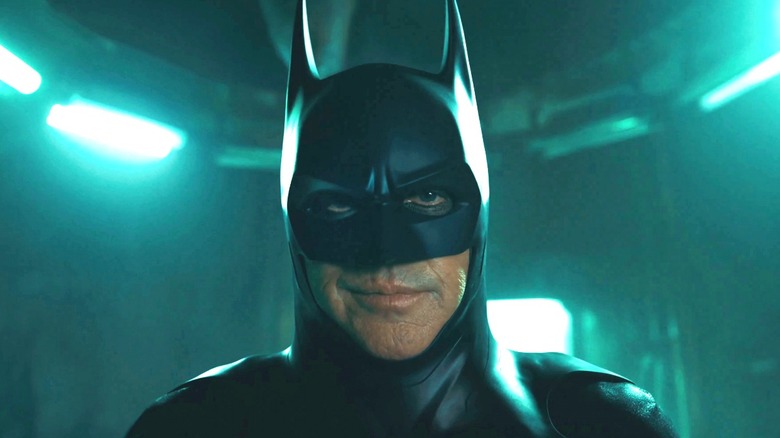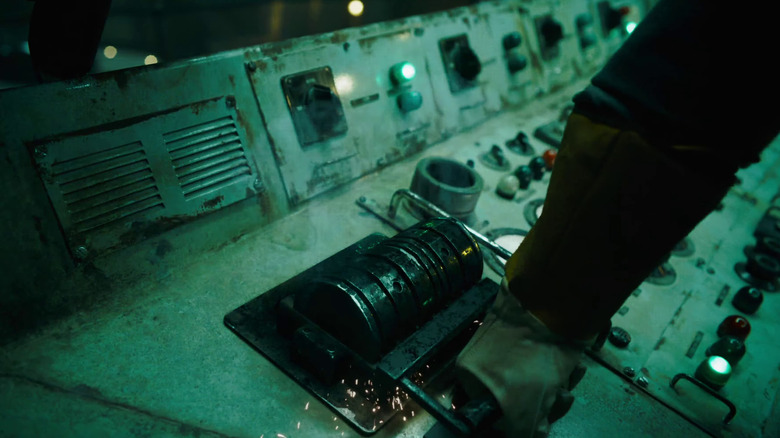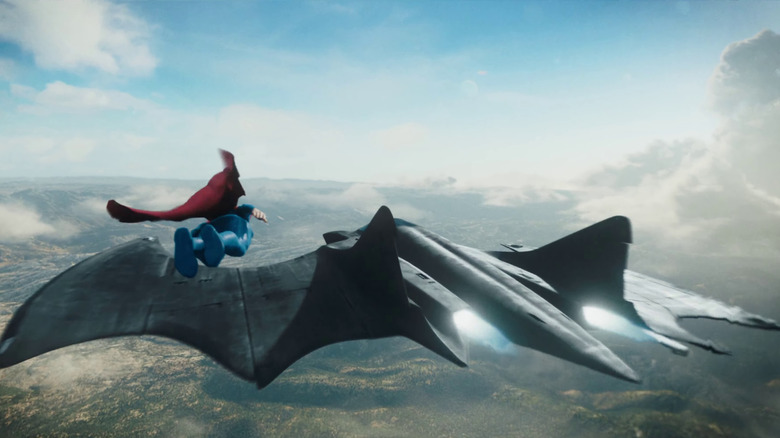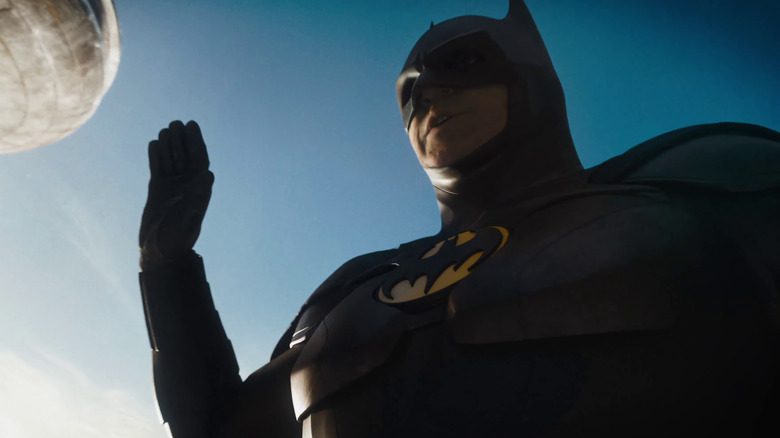Every Reference To The Original Michael Keaton Batman Movies In The Flash
This post contains spoilers for "The Flash."
In Andy Muschietti's new superhero film "The Flash" — one of the final pictures in the decade-old DC Extended Universe film series — Barry (Ezra Miller), aka the title hero, finds that he can run so fast he can enter an otherworldly realm that he calls the Speed Force. Access to the Speed Force allows Barry to travel back in time, a superpower he is eager to explore, as he might be able to travel back to his own childhood and save his mother (Maribel Verdú) from being murdered. Barry knows all about causality thanks to the movie "Back to the Future," a flick that gets namechecked multiple times throughout "The Flash."
What Barry hasn't considered is the way time functions in the DCEU. If he goes back in time, not only does he create an alternate future, but the timeline also skews backward into the past, altering things that had already happened. As such, when Barry does save his mother, he unwittingly altered the Batman (Ben Affleck) that he knew and loved. In the new timeline he created, the Caped Crusader is now played by Michael Keaton, matching his version of the character in Tim Burton's 1989 film, "Batman." Bruce Wayne is now an older man, and was so good at his job, he essentially retired.
Seeing Keaton as Bruce Wayne is, of course, a fantastic piece of nostalgia bait for fans of Burton's films. Not only does Keaton play the role, but he charges back into action in his old Batman suit, the same one he wore in 1989. When he puts it on, Danny Elfman's original score from Burton's film also fills the soundtrack.
The references are myriad besides.
The Batcave
Fans of the 1989 film can quickly fill their Easter egg baskets while watching "The Flash." When Barry — traveling with a time-travel duplicate — goes to find Bruce Wayne, he finds Wayne Manor as it looked in Burton's film. Barry enters the building and quickly finds the armory, including a feathered suit of armor that Alexander Knox (Robert Wuhl) described as "King of the Wickerpeople" in 1989. The two Barrys also pass through a dining room with a very, very long table. The table was used for a date with Vicky Vale (Kim Basinger) in the original film, and Bruce Wayne had to get up and walk a great distance to pass her the salt. When Bruce and Vicky both realized it wasn't the most romantic locale, they retire to the kitchen to eat.
The kitchen where Bruce and Vicky finished their meal is also seen in "The Flash." It's where Barry and Bruce meet for the first time. Indeed, while Bruce explains the fineries of time travel to the Barrys, he prepares himself a plate of spaghetti. More is seen of the Wayne Manor kitchen in "The Flash" than in "Batman."
And, yes, Bruce still has a Batcave. Barry breaks into Batman's old headquarters and finds everything still functional. The computer bank that Bruce Wayne used in the 1989 film is still there with the same configuration. What's more, the 1989 Batmobile — the one that looks like a jet engine — is still parked on top of the same towering platform that it was on in Burton's film. One of the Barrys will take a nap in it.
The Batwing
The finale of Tim Burton's first "Batman" film involved the Batwing, Batman's personal attack plane. In a single fun shot, Batman flew the Batwing up above the clouds, and paused his flight right in front of the moon, forming the Bat signal for the benefit of the audience. The "Batwing in front of the moon" shot served as the cover for Danny Elfman's "Batman" soundtrack record.
The Batwing appears in "The Flash" as well. The Barrys and Batman fly it to the location of a dramatic rescue, and then again to the site of a major military battle. The Batwing looks a little different than it did in Burton's film, but is a far cry from the redesign it received in the 1995 film "Batman Forever." It's clearly the same Batwing.
As there are two versions of the Flash in this film, it becomes an issue as to which one will get to wear the one-and-only Flash suit. Because the Flash runs so fast, his suit was specially designed to reduce friction. It's a vital part of the superhero being able to use his powers. When the secondary Barry needs a suit, he has to construct one out of old Batman outfits he finds in Michael Keaton's Batcave. A keen eye will recognize from the fake musculature on the suit's abdomen that Barry uses the Batman suit as it appeared in "Batman Returns."
When it comes time to charge into action, Batman calmly says "You wanna get nuts? Let's get nuts." This is a repeated line from "Batman" that Bruce yelled at the Joker (Jack Nicholson) when he was trying to threaten the villain. The context is different, but the repeated line is still fun.
Other trinkets
During a daring rescue, Batman will have to use a belt-sized rocket to propel several people to safety on an elevator. Before detonation, he asks them all how much they weigh. This is a reference to the "How much do you weigh?" line he asked Vicky while using a grappling hook in 1989.
For Tim Burton's two Batman movies as well as Joel Schumacher's "Batman Forever" and "Batman & Robin," Bruce Wayne's loyal butler Alfred was played by the excellent Michael Gough. At the beginning of "The Flash," audiences see the version of Alfred played by Jeremy Irons from "Batman v Superman: Dawn of Justice" but it seems that Keaton's version of Alfred had died a while ago. Alfred left Bruce an engraved pen which someone handles and admires in one scene.
At the very end of Burton's '89 film, Batman bests the Joker, and the villain falls to his death from a tall church spire. The police later gather around the Joker's dead body, and it still seems to be laughing. Commissioner Gordon (Pat Hingle) reaches into the Joker's coat, looking for the source of the laughing, and he extracts a small velvet bag that contains some sort of electronic noise maker. The bag continues laughing.
In "The Flash," while the two Barrys are exploring the Batcave, one of them happens upon that bag. Barry is astonished that it laughs. The audience is astonished that a novelty product like the Joker's laugh box still works 30-some years later.
While not exact one-to-one references, Batman also uses smoke bombs, explosive pellets, and grappling hooks that bear a lot of Tim Burton's mechanized aesthetic. At final glance, there didn't seem to be any anti-shark bat spray.



